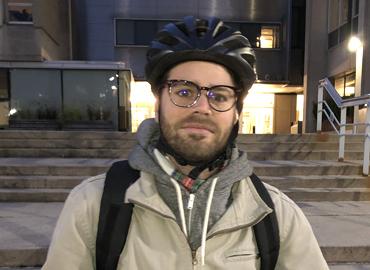PhD grad aims to make the world a fairer place when it comes to ride-share services
November 19, 2020 by Michael McKinnon – A&S News
Mischa Young came to U of T to earn his PhD in the Department of Geography & Planning in the Faculty of Arts & Science so he could better understand where the world is going — or, at least, how to improve the way they are getting there. His research into ride-hailing services like Lyft and Uber examined how this emerging form of mobility may be used to improve the sustainability and equity of our transportation network. As part of his thesis, he also identified segments of the population that benefit from ride-hailing, and more importantly, those who are excluded from it. His work was supported by several awards and scholarships, including U of T’s School of Cities Student Fellowship Award.
Why did you choose U of T and the Department of Geography & Planning?
I chose to pursue a PhD in the Department of Geography & Planning at U of T because many of its faculty members — and particularly my supervisor — specialize in urban transportation. The University’s interdisciplinary approach was another major reason for choosing this institution, as it enabled me to collaborate with faculty members from different departments and divisions including economics and engineering.
Tell me more about your research into ride-hailing services.
Despite their growing role within cities, the impacts of ride-hailing services remain contested and largely misunderstood. My doctoral research sought to explore several of the key impacts of ride-hailing on existing transportation systems and their users within the Greater Toronto Area and assess whether policies should be developed to encourage or deter its usage. More specifically, I identified potentially marginalized groups that may be excluded from ride-hailing services and exposed how the benefits of this mode may not be distributed equally. I also examined whether ride-hailing services behave as a substitute or supplement to transit, and proposed solutions to increase the share of pooled ride-hailing trips, such as UberPool.
What would be the best-case scenario result of your work?
I hope the results from my doctoral work will improve our understanding of the many ways in which ride-hailing services may impact our cities and, in so doing, offer a practical contribution to policymakers seeking to properly regulate this service.
What have you learned through this work? What’s been the big surprise?
My research suggests that new forms of mobility, such as ride-hailing services, will have an important role to play in the future of urban transportation. A surprise throughout this endeavour was the fast pace at which this industry and field of research evolved. The regulatory policies and level of data availability has changed substantially since I started working on this topic.
How has this work helped set you up for your post-university plans?
As a postdoctoral researcher, I am now building upon my doctoral ride-hailing research and am focusing on the driver side of the equation.
What advice would you give your first-year self?
Good question. I would tell my first-year self not to worry as much about clearly defining the scope of my doctoral research. These things tend to solve themselves along the way.
What have been some of your most memorable experiences at U of T?
Among the many memorable experiences at U of T, one that particularly stands out is the many hours spent at the Graduate Student Union Pub with my lab mates from the Spatial Analysis of Urban Systems Laboratory (SAUSy lab).
What’s next for you?
Since graduating from U of T, I have started a postdoctoral researcher position at the University of California, Davis’ Institute of Transportation Studies. In this role, I am working closely with the State of California’s Air Research Board to find ways to reduce transport-related greenhouse gas emissions.
This article was originally published by UofT Faculty of Arts & Science News



